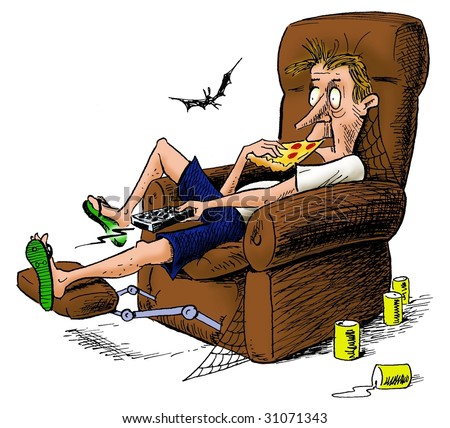But let's explore something more global, something that affects us in all scenarios and pretty much all the time. Today's observation is about comfort zones. This is something that should be considered on-top-of our character's objectives. Take for example, our character wants to eat some pie but there are spikey obstacles in the way. Our character won't be running across it to get to the pie if it's going to hurt him or cause him discomfort. Ok, that's quite an extreme case but this can be really effective if used in more subtle ways.
In the biological sense, our body is always finding ways to use the least amount of energy possible and to be as comfortable as possible. Say you're at home and sat down watching TV. A few minutes later, you'll find that your body is completely slumped. And if you get any lazier, you'd fall asleep. Biologically this makes sense because we need to conserve energy for when we need it - in the case of danger. Similar reasons to why our heart beats faster when we're afraid, to make sure our body is ready to flee or fight. So the next time you're animating a character doing an action, it's useful to think about how "comfortable" they are. It helps add that bit of realism to your piece doing things that people naturally do.
We also move in reaction to our comfort zones. When someone we don't know or don't like moves too close to us, we move away. This is best observed at the bus stop. When there are few people at the bus stop and you're stood on one side of the bus stop and another person comes up right next to you, chances are you'll feel very uncomfortable. The funny thing is that your comfort zone is adaptable depending on the situation. If the bus stop was packed with a lot of people, and you are sandwiched between others, it becomes acceptable because everyone else is in a similar situation.
The more we understand about what makes us or our characters comfortable or uncomfortable will help make our character's interaction with others in the scene a lot more believable. So the next time you make your animation poses, ask yourself if it looks comfortable in etiher a) as a normal balanced pose or b) comfortable in the situation.
Apart from the main objective that our characters are going through, do remember that there are also a lot of subconscious things that our bodies will do naturally to support our actions. The more we observe the nonverbal clues of body language, the more we can accurately display genuine actions for our characters. I used to believe secondary action is something you add to your animation for extra awesome sauce. It's not. It's something you consider before-hand and apply consciously throughout your animation for all the right reasons.

